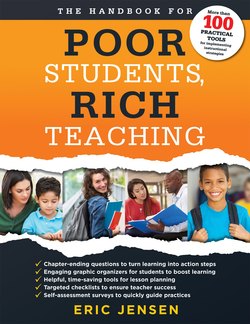Читать книгу The Handbook for Poor Students, Rich Teaching - Eric Jensen - Страница 8
ОглавлениеPART ONE
IMPLEMENTING THE RELATIONAL MINDSET
In this part, we begin with building the narrative of relationships as the core underpinning of high-performance teaching with students from poverty. Sometimes we find it easy to connect with students who share our own background, but it becomes much more challenging with students who don’t; yet it’s essential to build relationships with those students before any real learning can happen. If you’re not connecting by giving respect, listening, and showing empathy, you risk losing your students. When students lose interest in school, they will most likely find somewhere else to invest their energy and may make poorer choices. Some will get their respect and connections through peers and sports, others through drugs or even gangs.
To begin this part, use figure P1.1 (page 6) to self-assess how you already approach building (or not building) relationships with your students.
As you think about your answers to these questions, it’s paramount for you to build your awareness that all of us are in this together—you, me, colleagues, students, and parents. Relationships between everyone that touches students’ lives affect their success. When your students succeed, you succeed. There is no us (teachers) and them (students). Maintaining an erroneous narrative of separation will ruin your chances of success in teaching. The relational mindset says, “We are all connected in this life together. Always connect first as a person (and an ally) and second as a teacher.”
The relational mindset says, “We are all connected in this life together. Always connect first as a person (and an ally) and second as a teacher.”
Figure P1.1: Assess your understanding of how poverty affects students.
Visit go.SolutionTree.com/instruction for a free reproducible version of this figure.
Do not confuse this mindset with me telling you that it is impossible to succeed with every student unless each likes or respects you. Some students (those from strong, intact families) come from such stability at home that they need less relationship time at school. When a student has an emotionally stable family, good friends, and positive relatives, the need for relational stability at school is less. Ask yourself, “How can I show my students I care about their home life as well as their classroom life?”
Your students will care about academics as soon as you care about them. As neuroscience tells us, we are hardwired to connect (Commission on Children at Risk, 2003; Moriceau & Sullivan, 2005), and effective teacher-student relationships contribute to student achievement. Also, this contribution varies depending on students’ socioeconomic status and grade level. The research tells us that relationships mean more to students who have instability at home than to students who have a stable, two-parent foundation (Allen, McElhaney, Kuperminc, & Jodl, 2004). Among all students, good relationships have a 0.72 effect size, which makes them an exceptionally significant and strong effect size catalyst (Hattie, 2009). Among secondary students, the effect size is an even larger 0.87 (Marzano, 2003).
The scope of the relational effect goes much further, and I explore it in depth in Poor Students, Rich Teaching, Revised Edition (Jensen, 2019). The bottom line is that relationships influence engagement in multiple ways. First, quality interactions within a relationship provide instruction, correction, modeling, and support for students, forming the basis of a teacher-student relationship (Hughes & Kwok, 2006). Second, a positive teacher-student relationship enhances students’ sense of classroom security and increases their willingness to engage in the classroom (Baumeister & Leary, 1995). Third, evidence shows that quality relationships can help students achieve more through greater connected engagement (Roorda, Koomen, Spilt, & Oort, 2011). Another study reveals that students’ positive or negative classroom relationships are equal to IQ or school achievement test scores in predicting if a student will drop out (Jimerson, Egeland, Sroufe, & Carlson, 2000).
The next three chapters offer the following strategies to help you build relationships with your students that will get them on board emotionally and socially.
1. Personalize the learning.
2. Connect everyone for success.
3. Show empathy.
In these chapters, you’ll see how relationships offer the emotional environment through which all course content flows. There is no classroom content without some sort of context, even if the context is a digital device. Let’s dig in.
Questions for Daily Reflection
Each day, consider your own mindset for fostering connection and relationships with your students, and answer the following questions.
1. Have I recently seen other teachers successfully build quality relationships with their students? How did they do it? Could I do something similar?
2. Which students in my classroom have I not taken the time to get to know? In what ways can I connect with those students that will make a difference for them?
3. Are there students in my classroom who appear to feel unsafe, not respected, or disconnected from their peers? How can I change those things?
